Brian Meert's Blog, page 52
June 15, 2023
The Best Facebook Marketing Guide You Must Have
Are you seeking the best Facebook marketing guide to help take your digital presence to the next level?
According to DataReportal, Facebook has almost 3 billion active users. So, it’s the ideal marketing platform for businesses and organizations that want to promote their services or products.
Our guide includes the information you need to run effective campaigns. Moreover, we’ll share detailed instructions on boosting engagement, generating leads, and increasing conversions through Facebook.
Read on as we cover the following:
Begin Your Facebook Marketing
Guide for Effective Facebook Marketing
Final Thoughts on Facebook Marketing
Frequently Asked Questions on Facebook Marketing
Begin Your Facebook Marketing
Facebook presence lets small businesses connect with their current and potential customers.
Before we get into Facebook marketing tactics, use this beginner’s checklist to set your marketing strategy up for success:
Make a Facebook business page. A Facebook business page is like a regular Facebook profile. Submit your brand name and add a profile picture and cover photo. Moreover, tell people about yourself in your bio. Then you can reach out to people who will follow or like your page.
Open a Facebook shop. If you want to sell products online, you can use Facebook Shops. Your shop will let people buy items from your business without leaving the Facebook app.
Make a Meta Ads Manager account. If you plan to advertise, an Ads Manager account can help you promote your business. It has special features that let you reach your target audience.
Set up the Meta Pixel. Meta Pixel helps you reach more people with your ads. Moreover, this feature provides insights into the actions people take on your website.
Guide for an Effective Facebook Marketing
About 80% of small businesses use Facebook as a marketing platform, especially since it has proven to be a profitable sales channel.
So, investing a few hours each week in managing social media can benefit your business.
Here are some tips on implementing effective Facebook marketing campaigns:
Know your target audience.
People have chosen to follow you on social media, which means they will see your content in their news feeds.
You’d want to attract people who are interested in your products. So, even with 20,000 followers who are not interested in what you sell, your ads won’t be successful. After all, these people have no intention to buy from you.
You need to know who your customers are to use Facebook for ads effectively. Consider what your buyers and customers have in common.
Use these elements to create content for the platform. It would help if you focused on the following traits:
Demographic data (age, gender, location)
Interests
Purchase intent
Pain points or challenges
Objectives and desires
Consolidate and review customer feedback surveys, Google Analytics, and competitor analysis.
Elevate your content.
1,500 Facebook posts are qualified to appear in a user’s news feed every day.
You can elevate your content strategy and attract competition by combining the following formats:
Video. Post videos directly on your page, stream them live, or publish them as a story. Facebook likes good quality videos because they make people spend more time on the app.
Images. Pictures are more easily seen in a news feed when accompanied by text. Post photos from behind the scenes or pictures of customers using your products.
Text-only posts. Some companies do well when they post longer stories on Facebook. People generally like posts like this, but it depends on who reads it. It works best when you are telling a story.
Here’s an example of how AdvertiseMint incorporates image-based news feed posts into its social media content strategy.
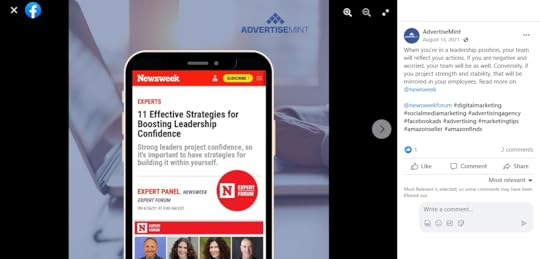
It is important to use your Facebook posts to build relationships with people. Try different types of content to see what works best.
Schedule your social media posts when your followers are most active.
If you use Facebook for your business, post when your target audience is online. Late-night publishing means competing with too many posts in the morning. Consequently, people won’t see them.
Research shows the best time to post on Facebook is between 7 a.m. and 9 a.m., from Monday to Thursday. Optimal times for your small business on Facebook may vary based on the following:
Your follower’s time and location. Suppose you begin scheduling several Facebook posts for 9 a.m. daily in North America, but your target audience is in Australia. So, if it’s 9 a.m. in your location, it would be 1 a.m. in the area where your audience is located.
Selling to businesses (B2B) or consumers (B2C). There is a link between people’s Facebook usage and their daily routines. For instance, office workers use Facebook while commuting or during lunch breaks.
Schedule content at contrasting times throughout the week and monitor your Facebook Insights to find optimal posting times.
Share influencer or user-generated content and partnerships with other brands.
Marketing is all about influence. Whether you’re convincing your Facebook followers to like your posts or to purchase a product you’re promoting, get assistance by partnering with influencers.
Popular social media users influence each generation, particularly ages 20-29 and 13-19.
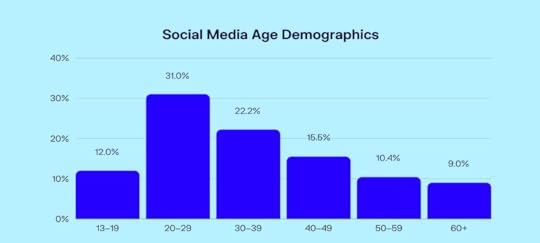
Popular methods to collaborate with influencers:
Finance for a sponsored post.
Let the influencer “take charge of” your Facebook page for a day.
Mail free products to the influencer with the hope they’ll share it with followers.
Your Facebook page can grow even with the help of influencers who have a limited number of followers.
Moreover, you can collaborate with other brands and influencers with similar target markets to expand your audience base.
Get recommendations and reviews.
Most people look at reviews before buying something online. Customers who are happy with your company can tell others, which will help attract people to your small business.
People using your product or service can be beneficial when reaching new customers. Find your Facebook reviews by going to facebook.com/username/reviews.
Direct existing customers toward the link through purchase confirmation emails.
Moreover, incentivize reviews and reward repeat customers. For example, give a 10% discount code redeemable on their next transaction or in exchange for a testimonial.
Join Facebook Groups.
You can talk online about the products you like. Over 1.8 billion people worldwide use Facebook groups monthly to connect with others.
Ask your customers what Facebook groups they use to determine where your target market is engaged. You can also search on Facebook for your industry and look at the groups that show up there.
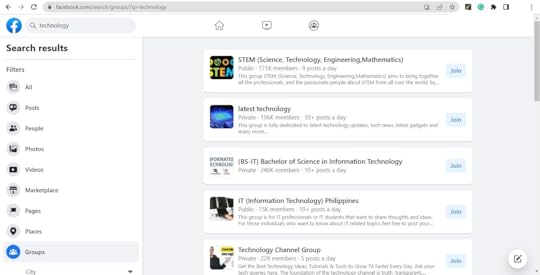
To be seen more on Facebook, you should comment on posts in the group. However, remember that some groups have rules you must follow. Otherwise, they might stop you from posting. Check the rules before posting anything to make sure it is allowed.
Monitor your Facebook insights.
The secret to Facebook’s marketing success is trying new things. What works for one small business may not work for another. So, you should be flexible enough to see what’s effective for you.
Know whether your strategy is working by monitoring Facebook Audience Insights. Important metrics to pay attention to include:
Follower demographics. Check if people who follow you on Facebook will buy from you. Look at your Facebook followers’ countries, ages, and genders to see if they match those you want to sell to.
The number of unfollows. Once someone follows your Facebook page, your job doesn’t stop there. You can measure how you’re doing by reviewing the number of unfollows.
Where follows happen. Find out where people discover your page. Monitoring followers will help you ensure that more people see your page, which is especially important if you need to spend more time marketing your Facebook page.
Actions on the page. What is the number of people who click your Facebook page’s call to action (CTA)? See whether your organic content drives people to visit your website, ask questions, or reach your small business.
Success by post type. It is a good idea to vary your content when advertising your business on Facebook. Look at this report to see which posts your audience likes the most.
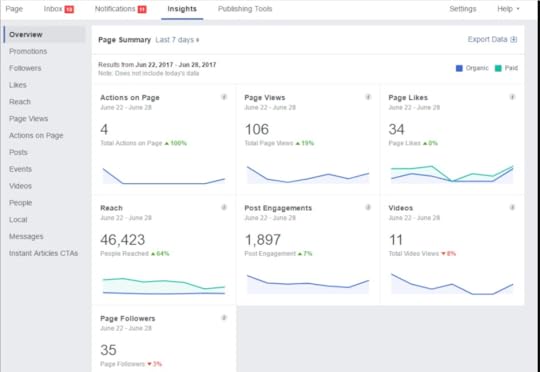
Improve advertising targeting for website visitors.
You can advertise your business on Facebook for only $5 a day, which will help get more people to see your website. It would help if you ran ads often to reach the right people.
If you are new to Facebook advertising, show ads to people who already know your business and product. It will be easier since they already know about you.
Create Facebook custom audiences for people who have:
Visited your website.
Interacted with your mobile app.
Engaged with a video you posted to Facebook.
Bought a product from you.
Set up Meta Pixel on all your platforms, which will help you get information about Facebook users who interact with your website or app.
If you own a small business, you can use Custom Audiences to retarget people. After all, 97 out of 100 visitors leave a website without buying anything.
You can remind these visitors about what they want to buy by showing up on their Facebook news feed.
Run Facebook ad campaigns with influencer endorsements.
We’ve already touched on influencers’ power when marketing a business on Facebook.
Include influencer endorsements in your Facebook ad campaigns to build trust and credibility.
Perform A/B testing tool.
The first Facebook ad campaign you make will be different from the winner. Much like organic posting, the advert with the highest return on investment needs some experimentation.
Run Facebook’s built-in A/B testing tool to experiment with the following:
Ad format. Facebook ads come in different types. Some get more attention than others. So, try different styles and see which your target audience likes the best.
Placement. The Facebook news feed is a good place to show ads, especially for small businesses. Try other places like the right-hand column or Meta Audience Network to see if your ads improve.
Campaign objective. Facebook has a tool that helps businesses advertise. Local businesses can use the tool to get people to like their page or sign up for something. Meanwhile, e-commerce companies can use it to help them sell products.
Call to action. Below your advertisement, there is a small button. Find out which of the three options, “Book Now,” “Shop Now,” or “Learn More,” will help people do what you want them to.
Convert your Facebook followers into subscribers for your email list.
Building an audience for your Facebook pages is beneficial because having more followers means a bigger group for promotion.
Despite the hard work put in by marketers to build an audience on Facebook, the platform’s algorithm changes. Moreover, its limitations on organic reach can impact your ability to connect with your audience.
So, some marketers view Facebook marketing as constructing an audience on borrowed land. There’s always the risk of pages getting shut down.
To decrease risk, you can convert your Facebook audience into email subscribers. You can do this by using ads that lead your target audience to a lead magnet, such as:
Quizzes
Coupons
Free workbooks
A direct line of communication with your desired audience will enable you to contact them in case of unfortunate events.
Final Thoughts on Facebook Marketing
Despite the controversies surrounding Facebook, it still presents an important opportunity for marketers to connect with their target audience, no matter their budget.
Marketers can enhance audience engagement by testing different content formats, campaign goals, and posting schedules.
Moreover, they can use Facebook Insights to determine which strategies work best for increasing conversions among their audience.
Is your company seeking to enhance its marketing strategies? AdvertiseMint, the premier social advertising agency specializing in Facebook and Instagram ads, can assist you.
Check out AdvertiseMint’s user-friendly marketing guides and the related articles section of this blog post.
Frequently Asked Questions on Facebook Marketing
Is Facebook marketing free to use?
Creating a Facebook Page or Group for your business is free, but you must pay if you want to use Facebook Ads. Depending on your ad type, the cost is per click or impression.
What are some ways to increase the number of followers on my Facebook page starting from scratch?
Consider investing in ads to grow a Facebook page through social media marketing quickly. Choose the campaign objective as “Page Follow,” define your target audience, and spend at least $1 daily to increase your follower count rapidly.
How can I make effective Facebook ads?
To maximize the effectiveness of your images and videos in ads, keep them simple and highlight your call-to-action and value proposition.
It’s important to determine your advertising goals in advance so that you can choose the most appropriate ad format for your needs.
Related Articles
A Complete List of Facebook Marketing Partners, Advertising Agencies, Influencers, and Resources
Tips on Making a Killer Facebook Marketing Strategy
What Is Cost Per Click? A User’s Guide to Facebook Advertising
{"@context":"https://schema.org","@type&... Facebook marketing free to use?","acceptedAnswer":{"@type":"Answer","text":"Creating a Facebook Page or Group for your business is free, but you must pay if you want to use Facebook Ads. Depending on your ad type, the cost is per click or impression."}},{"@type":"Question","name":"What are some ways to increase the number of followers on my Facebook page starting from scratch?","acceptedAnswer":{"@type":"Answer","text":"Consider investing in ads to grow a Facebook page through social media marketing quickly. Choose the campaign objective as \"Page Follow,\" define your target audience, and spend at least $1 daily to increase your follower count rapidly."}},{"@type":"Question","name":"How can I make effective Facebook ads?","acceptedAnswer":{"@type":"Answer","text":"To maximize the effectiveness of your images and videos in ads, keep them simple and highlight your call-to-action and value proposition.\n\nIt's important to determine your advertising goals in advance so that you can choose the most appropriate ad format for your needs."}}]}
May 17, 2023
Does TikTok Advertising Work?
The answer is a yes, TikTok ads can be very effective for small, medium and enterprise sized businesses. In fact, a study by TikTok found that businesses that use TikTok ads see an average of 300% increase in brand awareness and a 200% increase in website traffic. TikTok, a popular short-form video-sharing app, has witnessed explosive growth in recent years. With over 1 billion active users and engaging content, businesses have increasingly turned to TikTok for advertising opportunities. There are multiple reasons why TikTok advertising truly works and sheds light on its effectiveness as a marketing platform.
The Power of TikTok’s User Base: TikTok boasts an extensive global user base, with over 1 billion active monthly users as of 2021. This massive audience offers businesses a vast potential reach, especially among younger demographics. The platform’s algorithm-driven content discovery enables advertisers to target specific user segments, ensuring that their content reaches the desired audience.Engagement and Virality on TikTok: TikTok users are highly engaged. They spend an average of 90 minutes per day on the app, and they are more likely to interact with ads than users on other social media platforms. The platform’s short and visually captivating videos have the potential to go viral quickly, increasing brand exposure exponentially. TikTok’s algorithm prioritizes content based on user preferences, increasing the likelihood of ads being seen by interested viewers, enhancing the effectiveness of advertising campaigns.Influencer Marketing and Collaborations: Influencer marketing has become a prominent strategy on TikTok. Influencers with large followings can promote brands and products, leveraging their influence to drive sales and increase brand awareness. Collaborating with TikTok influencers can be an effective way to tap into their engaged audience and benefit from their credibility and authenticity.Creative Advertising Opportunities: TikTok offers various advertising formats, including in-feed ads, branded effects, and hashtag challenges. In-feed ads appear seamlessly within users’ “For You” page, blending in with organic content. Branded effects allow businesses to create interactive filters and effects, enhancing brand recognition. Hashtag challenges encourage user participation and content creation, driving user engagement and promoting brand interaction. TikTok ads are highly creative and often require a low barrier of entry for creatives. Its a place where Brands can let their hair down and bring in a human element to the ads. TikTok users are used to seeing short, funny, and engaging videos, and they are more likely to pay attention to ads that follow this format. In addition, Tiktok has rapidly been increasing their ad platform capabilities. Businesses can generate leads, drive sales, build shops on TikTok and implement new ad features like TikTok Pulse, which allows you to show ads next to the most popular content on TikTok.Tracking and Analytics Capabilities: TikTok provides advertisers with robust tracking and analytics tools to measure the performance of their campaigns. Advertisers can monitor metrics such as impressions, click-through rates, engagement, and conversions. These insights enable businesses to refine their targeting strategies, optimize their content, and make data-driven decisions to improve campaign effectiveness.Tips for creating effective TikTok ads:Use high-quality creative. TikTok users are used to seeing high-quality, engaging videos, so make sure your ads are up to par.Keep your ads short and sweet. TikTok users have a short attention span, so keep your ads under 60 seconds.Use humor and creativity. TikTok users love humor and creativity, so use these elements to make your ads stand out.Target your ads to your ideal audience. TikTok offers a wide range of targeting options, so use them to reach your target audience.Track your results and adjust your campaigns accordingly. Track your results so you can see what’s working and what’s not. Then, adjust your campaigns accordingly to improve your results.TikTok advertising has proven to be a powerful marketing platform for businesses aiming to reach a large and engaged audience.
The app’s extensive user base, viral potential, and influencer marketing opportunities offer unique advantages. Additionally, the platform’s creative ad formats and tracking capabilities empower advertisers to create compelling content and measure its impact. However, as with any advertising channel, success on TikTok requires careful planning, strategic targeting, and a deep understanding of the platform’s dynamics. By leveraging the strengths of TikTok and tailoring campaigns to suit the platform’s unique features, businesses can effectively harness its advertising potential and achieve meaningful results.
TikTok advertising is a powerful tool that can help businesses of all sizes reach their target audience and grow their business. If you are looking for a way to reach a large and engaged audience, TikTok advertising is a great option.
If you are looking for help managing your TikTok ads, please contact AdvertiseMint and our friendly team can walk you through your options on how our agency helps manage your ads to ensure they are profitable and growing your business.
May 16, 2023
Why businesses should spend time and money on paid ads instead of posting organic content on social media.
In recent years, organic social media exposure has experienced a noticeable decline, presenting challenges for businesses aiming to reach their target audience effectively. Platforms such as TikTok, Facebook, and Google have become saturated with content, making it increasingly difficult for businesses to gain visibility organically. Consequently, companies are turning to paid advertising to amplify their reach and achieve their growth objectives. There are many factors contributing to the decline in organic social media exposure and highlights why running paid ads on platforms like TikTok, Facebook, and Google is now essential for business growth.
Increasing Competition and Algorithmic Changes: The explosive growth of social media has led to a significant increase in the volume of content being shared daily. As a result, platforms have implemented algorithmic changes to prioritize content that engages users the most. These changes aim to enhance user experience but have inadvertently limited the organic reach of businesses. With algorithms favoring posts from family, friends, and highly engaging content, brands find it harder to appear in users’ feeds organically.Saturation of Social Media Platforms: The popularity of social media platforms like TikTok, Facebook, and Google has attracted a vast number of users and businesses alike. As a consequence, these platforms have become saturated with content, creating a crowded digital landscape. In such a highly competitive environment, relying solely on organic reach may result in limited visibility, as businesses struggle to cut through the noise and stand out from the crowd.Decline in Organic Reach: The decline in organic reach on social media platforms has been observed across the board. Facebook, for instance, has continually reduced the visibility of organic posts from business pages in users’ news feeds, encouraging brands to adopt its paid advertising solutions. Similarly, TikTok’s algorithmic changes have made it harder for businesses to achieve significant organic reach, leading them to explore paid ad options for better exposure. Google’s search engine algorithm updates have also influenced organic visibility, necessitating businesses to invest in paid search ads to maintain a competitive edge.Benefits of Paid Advertising: Paid advertising on platforms like TikTok, Facebook, and Google offers several benefits that can support business growth. Firstly, it allows precise audience targeting, ensuring ads reach the right people at the right time, increasing the likelihood of conversions. These platforms provide advanced targeting options based on demographics, interests, behaviors, and location, enabling businesses to refine their campaigns and maximize their return on investment.Paid ads offer superior visibility and reach compared to organic content. With the ability to place ads in prominent positions and target specific user segments, businesses can cut through the noise and reach a wider audience. This enhanced visibility contributes to increased brand awareness, customer engagement, and potential sales.
Paid social media advertising is a powerful tool that can help businesses reach their target audience and grow their business. Paid ads can be used to:
Increase brand awareness.Drive traffic to your website.Generate leads.Increase sales.Paid social media advertising can be very effective, but it is important to do it right. There are a number of factors to consider when creating and running paid social media ads, including:
Your target audience.Your budget.Your goals.Your creative.Your bidding strategy.Paid advertising provides measurable results through comprehensive analytics and tracking tools. Businesses can monitor key performance indicators (KPIs) such as impressions, clicks, conversions, and cost per acquisition. This data-driven approach allows for ongoing optimization and refinement of advertising strategies, ensuring that resources are effectively allocated and delivering the desired outcomes.
As organic social media exposure continues to decline, businesses must adapt their strategies to remain competitive and foster growth. Paid advertising on platforms like TikTok, Facebook, and Google presents an effective solution to overcome the challenges associated with reduced organic reach. By leveraging the precise targeting capabilities, increased visibility, and measurable results offered by these platforms, companies can amplify their brand’s presence, connect with their target audience, and drive business growth. The decline of organic social media exposure has made paid social media advertising an essential tool for businesses of all sizes. If you are not using paid social media advertising, you are missing out on a valuable opportunity to reach your target audience and grow your business.
May 10, 2023
Google adds new AI features to Bard
Today, Google held its annual developer conference, Google IO. Among the many announcements made during the keynote address, one of the most exciting was the unveiling of Google Bard, a revolutionary new language processing tool that promises to change the way we interact with technology.
Google Bard is an AI-powered language model that is capable of understanding and generating complex language in a way that is more human-like than ever before. It combines the power of Google’s existing language models with new technologies that allow it to not only understand words, but also context, tone, and emotion. Bard is powered by Google’s LaMDA language model, which is one of the most powerful AI models in the world. LaMDA is trained on a massive dataset of text and code, and it can generate text, translate languages, write different kinds of creative content, and answer your questions in an informative way. Bard is still under development, but it has learned to perform many kinds of tasks, including:
Following instructions and completing requests thoughtfully.Answering questions in a comprehensive and informative way, even if they are open ended, challenging, or strange.Generating different creative text formats of text content, like poems, code, scripts, musical pieces, email, letters, etc.During the keynote address, Google demonstrated several impressive use cases for Bard. One of the most impressive was a live demonstration of Bard in action, where a user asked a complex question about the weather in a specific location, and Bard was able to provide a detailed and accurate response in a matter of seconds.
Another exciting use case for Bard is in the realm of virtual assistants. With Bard, virtual assistants can understand and respond to natural language queries in a way that feels more like a conversation than a command. This has the potential to make virtual assistants more intuitive and user-friendly than ever before.
One of the most exciting aspects of Bard is its ability to understand context and emotion. For example, if you’re typing an email and you use a phrase that could be interpreted as sarcastic, Bard will be able to pick up on that and suggest alternative wording that is more appropriate. This could be a huge boon for anyone who has ever sent an email that was misinterpreted due to tone.
Bard also has the ability to generate language in a way that is more human-like than ever before. For example, if you ask Bard to write a poem, it will be able to generate a poem that is not only grammatically correct, but also emotionally resonant. This has the potential to revolutionize the creative industries, as it could allow writers, poets, and other artists to collaborate with AI tools in new and exciting ways.
In addition to Bard, Google also announced a number of other AI-related features at IO 2023. These features include:
New AI features in Google Search: Google is adding a number of new AI features to its search engine, including the ability to generate summaries of long documents, translate languages, and answer questions in an informative way.New AI features in Google Docs: Google is adding a number of new AI features to its word processor, including the ability to generate text, translate languages, and write different kinds of creative content.New AI features in Google Sheets: Google is adding a number of new AI features to its spreadsheet software, including the ability to generate text, translate languages, and write different kinds of creative content.New AI features in Google Slides: Google is adding a number of new AI features to its presentation software, including the ability to generate text, translate languages, and write different kinds of creative content.Of course, with any new technology, there are concerns about privacy and security. Google has been very clear that it takes these concerns seriously, and that Bard has been designed with privacy in mind from the ground up. All data that is fed into Bard is encrypted and stored securely, and Google has put in place strict policies and procedures to ensure that data is not misused or mishandled.
Google has also emphasized that Bard is not intended to replace human language experts or writers, but rather to augment and enhance their abilities. As Google CEO Sundar Pichai noted during the keynote address, “We believe that technology should work for people, not the other way around.” Bard is designed to be a tool that can help people be more productive, more creative, and more effective communicators. Bard is still under development, but it has the potential to revolutionize the way we interact with computers. It could be used to provide customer service, write articles and blog posts, or even generate creative content like poems or music. Bard is still a work in progress, but it is clear that Google is making significant progress in the field of AI.
The announcement of Google Bard is a very exciting development for anyone interested in language, AI, or technology more broadly. It is still too early to say what the future holds for Bard, but it has the potential to be a major player in the AI space. Bard is still under development, but it has already learned to perform many kinds of tasks. As Bard continues to develop, it is likely to become even more powerful and versatile. With its ability to understand context, emotion, and tone, Bard has the potential to revolutionize the way we interact with technology, making it more human-like and intuitive than ever before. While there are certainly concerns about privacy and security, Google has made it clear that it takes these concerns seriously, and that Bard has been designed with these issues in mind. It will be fascinating to see how Bard is adopted and used in the coming years, and what new opportunities and challenges it will bring.
There are countless applications in the advertising world for AI tools like Bard and Open AI. Commercial scripts, ad copy, creatives and more have all been revolutionized. Ryan Reynolds recently created a Mint Mobile ad using Chat GBT. Our outlook is that these tools will help professionals move at a much faster rate and be far more effective in their day-to-day professions. A good example of this was this article, which was written using the following prompt “Write a 1000 word article recapping the announcements today at the Google IO event relating to Google Bard” on both Google Bard and Chat GBT. The information provided was merged by the writer into this article, edited, added some context and the final paragraph and then posted all within 15 minutes. Exciting times ahead in the world of advertising.
February 17, 2022
What is an Influencer, and What Can They Do For Your Marketing in 2022?

Everyone is talking about influencer marketing this year, but why is that? Well, influencers are projected to become even more important for businesses that want effective digital marketing in 2022. But what is an influencer’s role in marketing exactly, and why are they becoming so integral for serious sales and brand recognition?
In this article, we’ll cover all these questions and more so you know exactly what influencers can do for you, how to find the right one for your business, and important tips for hiring an influencer so you can ensure your collaboration is successful.
What is an influencer, and what do they do for marketing purposes?Influencers are social media users who have a large social media following and can influence purchasing decisions. An influencer can be anyone ranging from celebrities, e-celebrities, content creators, models, or even casual users who accumulated a large audience over time. Influencers are sought out for promotional purposes because they have an established following of potential customers that trust their input on purchasing decisions and product recommendations.

An influencer’s social media reach is measured by the number of people that follow them, their engagement rate or comments per post, and their previous successes promoting products and brands. The ratio between these factors regarding their importance for marketers has changed over time, which we’ll discuss later on.
Influencer marketing is a relatively new form of marketing involving social media influencers promoting products or services for an agreed fee and/or commission rate. Though technically new, it’s analogous to traditional marketing methods involving celebrity spokespeople and endorsements. It has proven to be an extremely successful form of marketing for businesses and lucrative for social media stars with a diversity of backgrounds and audiences.
What are some influencer platforms? What are the major social platforms for influencers?Influencer marketing is mainly done on social media platforms such as YouTube, Instagram, and TikTok, but can be done through other social media platforms that influencers use regularly like Snapchat, Facebook, and more. The most well-known platforms for influencers are YouTube and Instagram, both of which are home to the common types of influencer marketing: beauty, makeup, and fitness.
That being said, TikTok is one of the fastest-growing platforms for influencers in terms of audience and opportunity, and over the past few years especially, more platforms with different tools and types of content have become competitive potential for influencers as well. This is especially true for 2020-era influencers, which tend to represent a larger variety of communities and interests than the previous two decades.

The increase in the number of social media platforms people use on average and the increasing variety of content and influencer types means that more often than not, an influencer will use more than one platform. Despite this, influencers generally have one specific platform they’re known for most where their audience and social reach are the largest.
How to find the right influencers for your business or brandThere are a few ways to go about finding and selecting an influencer to collaborate with your brand.
Ideally, your social media marketing should be established enough to know which platform(s) to start looking on. From there, it’s a matter of researching the communities, content, and hashtags your target audiences are in and inevitably influencers and their content will show up. This can also be done using the audiences of competing businesses on their social media accounts.
Finding influencers organically through audience research and engagement within their communities is the best way to find influencers that are a good fit for your brand because it allows you to discover influencers with a reach that encompasses your target audiences.

Alternatively, if you don’t have the time or resources available for this type of research, you can find influencers for your brand using professional services. Third-party platforms like BuzzSumo can help you search for relevant influencers on various platforms while taking your business’s social media account into consideration. Platforms like TikTok and Instagram have their own suite of tools to help brands and influencers connect and collaborate on-site. This can be an inexpensive way for marketers and business owners to save time when finding and selecting an influencer, but they don’t make the process completely effortless and still require you to dedicate time to research.
Professional services for finding and hiring influencersFor those with larger teams and marketing budgets, hiring an agency can make finding an influencer fast and easy while minimizing risk.
Agents have enough experience in the industry to easily find quality influencers that can represent your brand’s products effectively and also take over the time-consuming tasks of outreach, vetting, and negotiation. For example, a brand working with a full-service TikTok ad agency or Instagram advertising agency for their marketing campaigns would only have to provide any preferences or requirements and give final approval after being presented with their best options – the agency can do the rest.

Depending on their success level, influencers often have their own agents to handle the tedious aspects of this process on their side. Influencers that are in high demand often receive numerous requests from hundreds of brands, so it’s important to know whether they have an agent handling brand sponsorships in order to know the most effective way to reach out to them with an offer.
What are the benefits of working with influencers?As stated previously, influencers have established audiences in their sphere of influence and are often regarded highly by their fans. This results in a high level of authority and trustworthiness and makes influencers more likely to be effective at promoting your brand.
This trust is what puts the “influence” in the term “influencer,” and it helps them promote a product or service in a way that is authentic and natural, which ultimately results in better sales conversions. In other words, because an influencer’s audience trusts them to create content that they feel genuine about, audiences are more likely to take their advice and act on it, whether that’s purchasing your product or service or sharing the social media post with friends.
Another important benefit that influencers can have for brands is that they’re digitally native to the platforms they’re using. Creating organic and authentic content on social media requires a thorough understanding of the platform and its norms, trends, etc. and it can be difficult for businesses to keep up with social media in this way.
It’s not uncommon to see a brand try to speak the language of their social media audience in an ad or upload by tapping into a trend or popular topic, only for it to fail miserably. This is not only a waste of marketing resources but can also tarnish the brand’s reputation or even result in backlash on a large scale if their marketing fail goes viral for the wrong reasons.

Social media influencers can allow brands to avoid this risk and help unlock the advantage that authentic, platform-native content can give to boost brand reputation, sales, and customer loyalty. They often help brands that are new to social media or influencer marketing to come up with creative content ideas and new ways to promote their brand in a way audiences will love.
What kind of return on investment (ROI) can you expect from working with influencers in 2022 and beyond?As social media advertising and social commerce become more common, influencer marketing is beginning to seem less like a novelty and more like an industry standard. Influencer marketing got an even bigger boost this past year as third-party data regulations and policy changes disrupted the effectiveness of digital ads.
Influencers can generate an impressive ROI for businesses sponsoring them, but the range is too large to give an accurate estimate. Each influencer is in a sense their own business with unique audience size, demographics, verticles, and so on. In other words, they’re too different to expect similar results from.

That being said, social media influencers generate over $9 billion in product sales annually and the industry has single-handedly launched emerging startups and small businesses into mainstream popularity.
Ask any avid YouTube viewer, for example, if they’ve heard of Dollar Shave Club, Hello Fresh, or Raid Shadow Legends. All of these businesses are recognizable names for most because the majority of their marketing is influencer marketing, predominately on YouTube.
In essence, a brand can expect massive payoffs from hiring an influencer, including ROI in the form of sales, signups, etc. But arguably, the ROI influencers provide is not easily quantifiable like conversions or likes. The reputation boost influencers can give businesses long-term can promote social credibility and social proof that will ultimately contribute greatly to the company’s overall market value.
How will the role of influencers change in the next decade, and how should businesses prepare for these changes?The social media industry is constantly evolving and influencers follow suit. For example, social media platforms have recently started to offer advanced tools for both businesses and influencers to integrate into their content. For example, TikTok now has shippable live streams and links that make product promotion easy for brands, influencers, and buyers alike. Because of this, businesses should expect influencers to become more heavily involved in the representation and promotion of brands on social media.

Furthermore, affiliate marketing, particularly for Amazon stores, is on the rise. This has led to a new type of influencer called an Amazon affiliate or Amazon influencer. These influencers are social media personalities that promote products through their social platforms, in most cases pulling in commissions on the sales they generate for Amazon.
Since these influencers create their own private affiliate links to share with their social followers, many businesses and product owners often see a substantial increase in sales and conversions and influencers can easily receive commissions without nearly as much time and effort involved in collaboration and negotiation.
This is evolving the industry in two ways: Firstly, it allows smaller influencers to work with brands more often, providing them more opportunities to grow and businesses the opportunity to reach new, unique audiences. Secondly, it’s diversifying the intensity required for sponsorships, resulting in less expensive and formal types of promotions and shoutouts.
Potential dangers associated with using influencers as part of your marketing strategyAs the influencer marketing industry has become more mainstream, the risks involved in selecting an influencer are decreasing as the process becomes standardized. However, that’s not to say there’s no risk for businesses at all, which is why vetting and account auditing is an important part of the selection process.
Instagram is easily the platform where scammy or negligent influencer marketing is most likely to take place. This is partly because of the platform’s exploitability, and also because Instagram’s position as a founding platform for influencer marketing means that many still don’t treat the process as seriously as it has become. That’s not to say Instagram is the only platform with bad influencers or practices, or that most Instagram influencers are bad. Still, it’s a good example to highlight because of the platform’s well-documented and pervasive challenges with influencer marketing.

Earlier we mentioned that the ratio of importance between an influencer’s follower count, engagement, and previous success has changed over time when determining their social reach. This is in large part because businesses learned the hard way that:
Lots of followers =! lots of engagement (and therefore less influence)Followers, like counts, etc. can be inflated with the use of bots and other malicious practices to make the influencer’s reach look larger than it really isThe context behind an influencer’s numbers matters when determining whether collaboration would be successfulNegligence and avoiding formal industry standardsAs influencer marketing becomes more intertwined with marketing as a whole, new regulations and best practices are added regularly that influencers and brands alike need to be aware of. This has helped turn social media influence and content creation into a bonafide career, but many still avoid following them either out of ignorance, negligence, or for their own personal gain.

On Instagram for example, influencers failing to properly disclose paid promotions is commonplace. Though this was always regarded as unethical, during the initial rise of influencers, no one was quite sure what its legal implications were. Nowadays, its legal implications are clear – both brands and influencers can face hefty fines and charges for doing so – but that hasn’t stopped many.
Influencers need to vet sponsors, tooAnother common issue is the selectiveness of influencers regarding the products and brands they promote. Just as influencers can influence a brand’s reputation, the same is true in reverse; they can run into embarrassing or damaging scandals if they don’t do their due diligence as well. Some common examples are crypto scams and “detox” (read: violent laxative) teas or “weight loss” (read: useless and expensive) programs and pills.
Other times it’s not the product itself that’s the issue but the way in which an influencer promoted it, or the fact that they promoted it. Plenty of influencers with younger audiences can find themselves in hot water when they promote age-inappropriate products, for example.

Others have received massive backlash for promoting cheap products in a misleading manner. Once-famous YouTuber Tana Mongeau, for example, was well-known for accepting bad promotions. One notable instance was when she promoted Kensa Cosmetics makeup brushes. They were marketed as originally $60+ but at a special discount, so viewers only had to pay the shipping fee. They turned out to be ~$0.10 per brush on Alibaba (slightly less than Kensa’s shipping fee, coincidentally). Tana’s audience consisted mostly of young preteen or teen girls, who are far less likely to question a deal their favorite storytime teller is raving about. Legend has it that some are still waiting for their brushes to arrive to this day.
These examples of bad influencer practices are important to know about and identify early on to ensure your investments are safe and your brand reputation isn’t put at risk. However, as stated previously, the industry is a lot more regulated and formal than even just a few years ago, so these issues are fading away over time and audiences are also learning to avoid them.
How you can ensure your relationship with influencers remains positive and mutually beneficialTo make sure that your relationship with any influencer your brand partners with and sponsors, be sure to keep the following in mind:
Always do your due diligenceThis is the most important thing that you can always be sure to remember and abide by – proper vetting and research often only takes time, but not doing so can be costly when it backfires. Take your time researching social media influencers, their content, social engagement rates, and get an idea of their audience. Consider auditing their profile for fake followers and potentially illegal activities like failure to disclose promotions or any of the bad practices we outlined above.

The biggest mistake brands make when working with social media influencers is not being completely forthright and open about what they expect from the influencer and what makes them a good fit for their brand. This could be as simple as a specific script they need to read from, or something more intense like collaborating on long-format video ideas. Additionally, make sure you confirm with the influencer that your expectations for them are realistic and they are comfortable with any preferences or requirements you have for the sponsorship or promotion.
Include any legal documents required by social platforms, sponsors, etc. in your contractSocial platforms have a number of regulations that must be adhered to, so social media influencers are required by social platforms like Instagram and YouTube to include certain legal documents in their contracts – a social influencer contract is usually required for social influencers with a large following. Be sure that you’re aware of these requirements when formulating your deal memo or social influencer contract to keep a clean paper trail and avoid any legal issues.
Involve the influencer in the creative process

Having a script to present to them initially or some specific requirements regarding how your product is presented is normal and often helpful. However, some businesses take it too far and as a result, they sabotage the influencer’s ability to deliver results. Scripts that are too intensive and don’t have any input from an influencer will sound out of character and come across as inauthentic. Oftentimes, some of the best and most adored promotional readings are ones in which brands give influencers plenty of room to do what they do best, which allows the promotion to blend in with the content instead of interrupting it (which people will often skip). Doing so increases your potential ROI and can help foster a long-term relationship with the influencer because you’re recognizing them as a content creator and not just your spokesperson.
ConclusionInfluencer marketing is always changing, adapting to social media trends, new social platforms, evolving social spheres, and most importantly – the demands of consumers. By 2022, social influencers will be even more crucial for businesses across all industries that are looking to grow through social content.
For businesses investing in social media marketing, influencers are only going to become a more lucrative and widely available method to effectively reach new customers and boost brand reputation. Knowing this, it’s important to adhere to ever-evolving regulations surrounding the industry, be thorough in the selection process, and properly recognize the creative ability and authority influencers have as expert trust-builders and sellers with their engaged audiences.
February 10, 2022
Thinking of Buying an Amazon FBA Business? Read This First.


Are you thinking of buying an Amazon FBA business? If so, it’s important to do your homework first.
In this blog post, we will discuss some of the things you should consider before becoming a new owner and seller. We’ll cover what Amazon FBA is, why someone would want to buy an existing FBA business, benefits and potential drawbacks, plus some key questions a potential buyer should ask before investing in one.
Basic Terms and Concepts to KnowBefore we get into the nitty-gritty of important details, let’s be sure we have all the basics covered. If you’re already experienced with buying an FBA business, you’re likely familiar with these already and can skip them.

A Fulfillment by Amazon (FBA) online businesses sell products on Amazon but do not directly handle shipping and returns. Unlike Fulfillment by Merchant (FBM) sellers, Amazon FBA sellers send their inventory to an Amazon warehouse where they are shipped to customers upon ordering.
This setup can help make selling and running an online business more profitable. However, the convenience of these services comes with related storage fees – knowing how this affects net profits per month is important before you buy.
What types of Amazon businesses are there?Besides the FBA vs. FBM differentiation listed above, there are a few different ways to categorize different Amazon businesses. First is by their account type:
Individual Seller Account: No account fees, but a $0.99 fee per item sold. This account is typically best for new sellers and those that resell unwanted items on Amazon Marketplace, and Individual Accounts lack a lot of necessary tools for selling at large volumes.
Professional Seller Account: $39.99 fee per month, with no fees per item sold. The fee gives sellers access to various tools and reports that help with inventory management, and they’re most beneficial for a medium or large-scale store with high sales volumes.
However, Amazon businesses can also be categorized by what they’re selling:
Retail Arbitrage: You’ll see these sellers in the “New & Used from” section because they’re reselling products and leveraging small price differences for profit rather than truly having their own brand or product.
Though it’s common on Marketplace and can generate lots of revenue, this category is also rife with misinformation and false promises. There are many claiming to sell courses on how to teach new owners retail arbitrage. Many will claim to see massive profits with minimal effort when in reality, few are actually successful.
Wholesale: These Amazon sellers buy products in bulk to sell at a profit, usually from suppliers or from a vendor.
Wholesale selling on Amazon can deliver consistent results and profit but also heavy competition. There are nearly always multiple other sellers on the market competing for reviews, rankings, and sales, making it difficult to become a best seller. Wholesale Amazon sellers may also need to follow more strict rules on how to operate (e.g., what they write on their listings) depending on their distributor or vendor.
Private Label: This practice involves taking a generic product (typically from platforms like Alibaba), slapping a brand name sticker on it, and selling it as a unique product. This is why you will often find eerily similar-looking products in search results despite all of them technically being a different business. Additionally, though it’s not always the case, private label products have a reputation for being cheap in both price and quality.
A business on Amazon can manufacture and sell its own unique products. Generally speaking, however, when you buy a business that already exists it is one of the three types above. Why? Because if not, you’d be talking about buying an entire business that likely has its own website or off-platform sales, and your role as the owner would be more akin to buying a large enterprise.
Why Should I Buy an Amazon FBA Business Instead of Starting My Own?There are many cases in which starting your own Amazon FBA business from scratch may be your best bet. However, many prefer to buy an existing FBA business because…well, it already exists.

Most Amazon business owners do not see success – it is a fiercely competitive environment, and it can be extremely difficult and time-consuming to stand out in search results.
Starting out from scratch means you’ll need to gather the ratings, reviews, and search rankings necessary to generate serious profits. Established FBA brands have already made it past that difficult phase and proven their viability (though that doesn’t mean the sales will continue – we’ll get to that later).
Consider These Points Before Buying an Amazon FBA BusinessPerhaps someone selling their successful Amazon store came to you personally, or you have become interested in the idea on your own. Before getting into the details of what factors about the seller and business you should consider, you need to be sure that an FBA business is the right move for you.
After all, you could buy a perfectly profitable account and later find that the process isn’t like selling as a regular online store – a common case for many empire flippers with eCommerce experience. Additionally, the time and effort involved to keep the account profitable might not fit your schedule or be worth the price for you personally.

Just because a business passed the difficult starting phase and generates a solid net profit does not mean it’s in the clear thereafter.
There are additional risks more specific to the platform as well: different types of account hijackers, listing sabotage, price wars, and other malicious practices from bad actors in your competitive environment are always around the corner. It can take days or weeks to address such concerns, and there are no safety nets for loss in sales you may have experienced in that period of time.
Lastly, there are a lot of variables that can be hidden to make a seller account look healthy and like a good investment at first glance. Buying an Amazon business requires a lot of due diligence and should be treated like purchasing any other company – we’ll cover what you need to know and ask before you buy an Amazon store later.
2) Just because you won’t have startup costs doesn’t mean you won’t have additional costs.You’re likely going to need a bit of cash to get started that’s not related to buying the account. FBA selling often requires large initial investments in inventory, advertising, and some buffer cash as you get the hang of your regular operations.
3) Steady income =! passive income.A lot of people – especially those aforementioned gurus – like to say that having an Amazon business is akin to passive income or a side hustle. This is technically possible, but extremely unlikely.
Many people starting from scratch are surprised when they discover just how much time is required to keep things going, or get high up enough in search results to see serious growth. In fact, it’s a big reason why many sellers don’t make it past one year even if their business was generating some profit.
You should consider how much time you’re also willing to invest in the brand you purchase in addition to your monetary investments. Factor this in when determining whether you’d be a good fit as the new owner. If you think that you may need to hire extra help (e.g. an Amazon advertising agency) in order to reduce the time you personally put into your store, keep in mind the money you’ll need for this too.
4) No two FBA businesses are completely alike.You could have two stores selling related products in the same categories, and you’ll still have two completely different stores to consider at the end of the day. Behind the scenes, there are so many factors and strategies that go into selling. Some do better than others despite seemingly identical verticals. For this reason, it’s important you deeply research the business, its customers, and its category before making any final decisions.
Answers to Common Questions About Buying an Amazon FBA Business

In most cases, they are sold through brokers. A good site to start with is BizBuySell. It compiles most offers from around the internet onto one place, which makes for easy browsing and discovery. A keyword search can help you filter offers for Amazon FBA businesses specifically. Inversely, if you’re hoping to sell an Amazon FBA business, this is a good place to list it.
How can I verify that an FBA business for sale is legitimate?It can be very difficult to verify the validity of an online business for sale, which can make the investment feel very risky, even for experienced empire flippers.
We will get into some questions to ask and tips to help ensure that you have the right information when looking at an offer. However, hiring a third party like Centurica to conduct Due Diligence services may be worth the extra money.
How much capital should I start with if I want to buy an FBA business?Generally speaking, it will cost anywhere from 2-4 times the business’s annual EBITA (earnings before interest, taxes, and amortization) to purchase an eCommerce business. As mentioned earlier, it’s best to also have additional money reserves enough to cover initial inventory purchases and in most cases, a marketing budget.
The exact number depends on the size, account health, and profitability of the store you’re intending to purchase. If you want to play it safe, consider adding on the sum of operational costs (including inventory) for at least 1 month in addition to the capital you will use to purchase the business. Additionally, factor in the money needed for any legal or consulting services to help with the purchase and transfer process.
What to Look For When Buying an Amazon FBA Business: Conducting Due Diligence

Here are some points you should consider when looking through Amazon stores:
Account HealthOne of the first things you want to look at is the health of the Amazon seller account. This will include factors such as how many products are listed, average sales volume, ratings and reviews, and feedback from customers.
An important and often overlooked area is the rate of returns for products. An otherwise successful, high-ranking account can end up taking huge profit losses due to returns. In addition to returns, be sure to look out for these smaller account health details:
Order cancellation ratesLate shipment ratesOrder defect ratesInventory performance indexDon’t be afraid to dive deep into customer feedback, and really take the time to read reviews. Doing so can ensure you pass up offers inflated by fake or bought reviews, which could not only result in an overvalued business but also could run the risk of you getting penalized due to platform rules later on.
Additionally, getting a good idea of poor reviews can help you determine your ability to fix any potential issues. For example, if the majority of bad ratings and reviews outline rude or lack of vendor response to order issues, this is something easily fixable on your end as you would now have direct control over it. However, if defects in products are the main concern, this could be a larger supplier issue that would require more effort and potentially capital to address.
CategoryThe second thing you’ll want to consider is what categories the business sells in. This will help you determine the amount of competition you may be dealing with in its marketplace, which plays a huge role in later investments like on-platform DSP advertising or off-platform marketing.
You should also consider the account’s positioning within its marketplace. This can help determine whether significant changes or investments will need to be made in updating product offers, optimizing listings, or expanding the business into new products and categories.
Lastly, take the time to determine whether you think there is still plenty of room for business growth within the category and specifically from the FBA account’s position. Some categories can be highly saturated, which would make an emerging seller’s likelihood of success much lower. On the other hand, some FBA accounts may have positioned themselves in lucrative niche markets full of potential.
Accounting RecordsWe’ll also include profit and loss statements as well as total fees from the platform here, which will give you a solid idea of what the Amazon seller account is worth, net profit, and so on. The past 12 months of operation are the most important for you when calculating value and determining whether the store is profitable.
Checking accounting records will also help you ensure that the FBA account was set up properly and the seller has kept accurate historical records throughout its operation.
Supplier Information and RecordsOne of the benefits of buying an established store is that you inherit a supplier network. However, this also comes with potential risks if the suppliers are not reliable or have inconsistent contact and communication.
The due diligence process should include verifying supplier information as well as checking to see if there are any records of late shipments, returns, or other issues with suppliers.
For Wholesale Accounts:This is important to consider if you’re buying an FBA business with the intention of expanding it into retail channels. Distributor relationships and agreements can be a great asset that you acquire as part of purchasing an FBA account, but they may also require an investment on your part to maintain.
Review the terms of any distributor agreements and be sure that you will be able to continue supplying products through those channels if you choose to do so in the future. If you intend to seek out new supplier agreements, be sure to read the fine print of any existing contracts to avoid any legal setbacks that could arise from clauses that define minimum time periods or competing suppliers.
Questions to Ask Before You Buy an Amazon StoreNow that we’ve covered the basics to consider and information to look through about buying a business, here are some questions you should have answers to before making any official agreements or transfers.

In most cases, a seller will have answered these questions before you even ask them, but double-check this list to be sure all bases are covered:
Why is this Seller Central Account for sale?You want to be sure you have all the details of why the FBA seller decided to put their store up for sale. Not only do you need to know any potential hurdles the seller encounter that made their venture no longer worth it (if any), but it’s also a great way to gauge how honest and straightforward a seller is with you.
Not all FBA stores that owners sell have issues impacting their profitability. Even in the case they do, there’s a chance your position and/or capital as an empire flipper could make it easier for you to promote growth to make it a perfectly profitable business, even if they couldn’t.
In the case that a seller isn’t completely honest about their FBA business for sale or its value, doing proper due diligence and going through the points mentioned above will ensure you catch this before it’s too late.
What are your lead times?Lead times are important for e-commerce enterprises that source inventory. It’s not possible to sell inventory you don’t have. Therefore, you want lead times from suppliers to deliver your inventory to be short. The quicker your inventory moves, the shorter your lead times should be.
If lead times seem to be long enough to impact sales, this may be a supplier issue that will force you to buy larger volumes at a time or even seek out new suppliers with better results.
Many store owners have experienced longer lead times across the board due to supply chain issues in the past year, especially for that source product from China or elsewhere overseas. This should be factored in when considering supplier-seller relationships and their overall reliability, but could still require you to seek a new supplier regardless.
What is your current marketing strategy?Nearly all sellers need some sort of Amazon advertising strategy in order to compete well within their category. In fact, many experienced sellers believe it’s not possible to grow a successful FBA business without using Amazon ads.
The most important things for you to know are whether the seller has a well-thought-out strategy and whether they are using Amazon PPC ads exclusively or if they have other social media accounts/affiliate marketing avenues.
Marketing off-platform and via Amazon DSP advertising has become more important for sellers to succeed in recent years, so what the seller already has established will determine how much money you’ll need to either expand or maintain its marketing strategy.
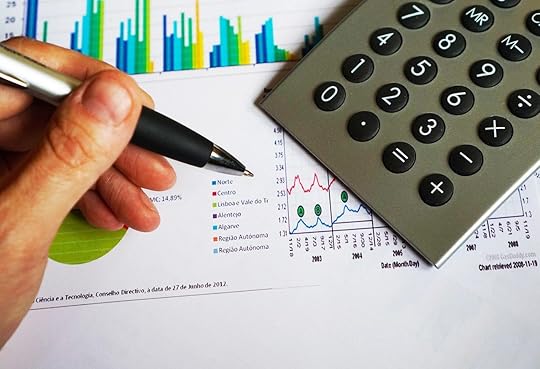 Pixabay Conclusion
Pixabay ConclusionBuying an FBA store is a great opportunity for those who want to enter the e-commerce industry but don’t want to make a seller central account from scratch. If you’re interested in buying a business, be sure to do your due diligence. If you’re not sure where to start, you can use these main points and questions to start the due diligence process yourself. There are also services you can use to assist with this process.
Remember that in addition to accounting records as well as category and customer research, other commonly overlooked factors like the previous seller’s marketing strategy or supplier lead times can play a large role in how valuable the business is long-term.
Not familiar with Amazon advertising strategy? Check out our article on the different types of Amazon sponsored ads, and subscribe to our newsletter below for news and tips on your favorite digital platforms every week!
February 3, 2022
Outsmart These 4 Facebook Ad Setbacks Caused By the iOS 14 Update


Here’s news you probably already heard: The iOS14 update has caused Meta (formerly Facebook) a lot of problems with their advertising business. Meta has already decided that their long-term solution is to build the metaverse, but the people using their ads can’t exactly wait out the massive decline in quality.
If you’re using Facebook or Instagram ads to increase your sales, get the word out about your brand, and find new customers, what can you do to help your campaigns avoid the common problems caused by the iOS14 update? Below, you’ll find 4 common issues Facebook ads users experience due to the iOS14 update, how to overcome them, and some general Facebook Ad tips to avoid further frustrations in the future.
1) Problem: Difficulty Optimizing Ad Spend and Higher CPAsWhy it’s happening: Pre-update, Facebook was able to use this data to measure conversions faster and better because it had consistent signals of data from each action being taken by a particular user. The time it took for Facebook’s algorithms to figure out the best way to place your ads according to your goal CPA (cost per acquisition) was very brief, because every single person viewing and clicking was providing it more context.
With the iOS 14 update, a big chunk of users won’t give the algorithms a lot to work with, so the period of time it has no idea what might optimize your ad placements according to your CPA is much, much longer.
As a result, advertisers across nearly all verticals have seen CPA increases of 20-50%, which can absolutely devastate ROAS (Return on Ad Spend) and make it very difficult for advertisers to know how to adjust their ad spend or scale their ads.

For years, testing out different campaign creatives, daily ad spends, and other campaign components was a matter of adding the change in, taking out any old creatives or underperforming setup options, and waiting a few days to see how it panned out. This is no longer the case.
Any time you edit your campaign, you’re restarting the process of Facebook’s algorithms figuring out how to optimize your ad.
Now that this phase is longer, that also makes testing and editing campaign elements and options incredibly expensive. By keeping your testing and scaling processes completely separate from each other, you’re ensuring that you keep this expensive phase of ad optimization as short and sweet as possible.
In other words, for every campaign you want to make, you should make a tiny budget testing campaign where it won’t absolutely kill your ROAS to make adjustments, and another campaign meant to be scaled using only the changes that have been tested and proven to bring better results. So if your previous Facebook advertising strategy used to look like this:
Brand Awareness CampaignEngagement CampaignConversions Campaign…and you’re experiencing problems with budget optimization, scaling, and/or high CPAs for Facebook Ads, try this setup instead:
Brand Awareness Testing Campaign ($)Brand Awareness Scaling Campaign ($$$)Engagement Testing Campaign ($)Engagement Scaling Campaign ($$$)Conversions Testing Campaign ($)Conversions Scaling Campaign ($$$)Keep in mind that the algorithms are still just as good at optimizing your ad placements as before; they just need a heck of a lot more conversions to get the same amount of data. This strategy of separating testing and scaling completely ensures the campaign you’re putting your real money into is using only proven changes that are worth the more expensive waiting period as the algorithms get the data they need.
2) Problem: FB Ads Conversion Reporting Numbers Aren’t ReliableWhy it’s happening: Data discrepancies in Facebook Ads reports are a result of the same issue as ad optimization issues: a loss of data overall.
The biggest difference between ad optimization issues and conversion tracking issues is that conversion tracking issues are a result of not being able to measure Facebook Ads data as thoroughly as usual. This problem only got worse with the iOS 14.5 update.
For advertisers who depend on Facebook’s conversion tracking – which comes in the form of pixel-based conversions data – this is a huge issue that can drive up costs and create uncertainty of the usefulness of ad spend, especially when you have gotten used to 8 different types of conversion events and a 28-day attribution window.
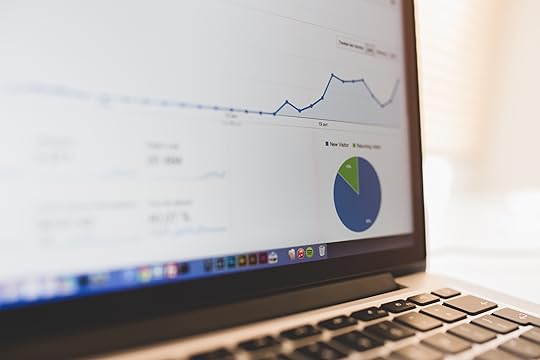
By default, even if you are using Facebook Pixel or Conversions API, you should start assuming that Facebook Ads reporting cannot provide you with comprehensive, accurate conversions numbers enough to be relying on it 100% as your source of truth.
So what do you do if you track conversions based on Facebook’s data?
You track them off-platform yourself and/or through a third-party platformYou keep your entire Facebook ad campaign and conversions on-platform – the most reliable and useful way to do so is using lead generation campaignsHow to track conversions for your Facebook Ad campaigns off-platformThe good news is that you don’t need to invest in any special tools or integrate anything unless you want to experiment for the sake of convenience. Even more good news, you can and should still use Facebook Pixel or Conversions API at the same time.
If you already have your own website, chances are you also already have integrations like Google Analytics to monitor traffic, sign-ups, and sales.
For those using Google Analytics, you can use the Google Campaign URL Builder to make a trackable link to use in your Facebook advertising campaign. The URL you create can serve as the destination URL for your ad campaign or can go in the optional URL parameters section.
So long as you’ve set up your UTM tags correctly, you can find your conversions data by logging into Google Analytics and clicking on Acquisition > All Traffic > Source/Medium.
Why Lead Generation Campaigns could be your iOS14-proof Facebook ad strategyLead generation campaigns avoid the reporting issue because they can achieve conversions in the form of sign-ups while keeping users on-platform the entire time. Your reports and results are more reliable because you’ve effectively minimized potential gaps in data.
Why should I make a lead generation campaign if the conversions I want are sales?Even if your end goal is a completely different conversion like sales, lead generation campaigns on Facebook can be a long-term strategy for your advertising success without third-party data. Lead generation ad campaigns build quality first-party data lists that you can use for your other campaigns and to build effective lookalike audiences.
3) Problem: Facebook Ad Targeting Isn’t Bringing ResultsWhy it’s happening: The fewer people that can be tracked across different sites, the smaller certain Facebook Ad Targeting Audiences are going to be. This is especially true for those who relied on Lookalike audiences as a staple for their ad campaigns because Lookalike audiences are constructed based on conversions data that’s now wildly inaccurate in many cases.
There’s also a second reason not directly related to the iOS 14 or 14.5 updates: Meta’s decision to remove certain types of targeting after they caused too much controversy.

The best way to get around this issue is by using your own first-party data, but getting enough of this data if you don’t have it already can take some time. So in the meanwhile, it’s time to re-strategize how you target different audiences.
Instead of relying on the ad platform to target audiences for you, hone in on creatives that will catch the attention of your niche audiences, while setting up your campaign using broad targeting.
How can broad targeting still effectively find specific target audiences?Again, keep in mind that Facebook’s algorithms still work just as great as ever in terms of optimizing where your ad is placed. So long as you ensure that your creatives are speaking to the right people within a broader audience, those within your target audiences will be the clicks, views, and conversions that teach the algorithm where and who to place your ad in front of for better results.
So in the end, you are still reaching and advertising primarily to your target audiences – you’re just using the algorithms ability to detect patterns to do so versus clicking a box from the start.
How do I know if my creatives can target my audiences well?A surefire way of making sure that your creatives can reach your desired audiences is by reusing or recycling creatives that have worked well for you in other campaigns. For example, if you had a very successful Google Ads campaign using a certain set of creatives, recycle them by ensuring they’re optimized for Facebook Ad Image Specs and to better fit Facebook Ad formats. Set up a small test campaign for A/B testing, make a few other adjustments if needed, and voila!
In fact, now might be a good time to dig up and relaunch or recycle an entire Facebook ad campaign that worked for you pre-iOS14. Those campaigns still have vital data points that can greatly reduce the longer optimization phase of the algorithm and reach target audiences. You might have an older campaign that doesn’t require extensive changes in setup in order to be relevant now.
4) Problem: Retargeting Audiences Are Too Small to Deliver ResultsWhy it’s happening: Retargeting audiences have been equally impacted by the iOS14 update as lookalike audiences, especially if you have a very niche product or audience. Apple iOS device users can’t be tracked enough to even know whether they belong in your retargeting audience or not anymore, which has made this audience shrink drastically.
Without a change in strategy, using retargeting audiences for a Facebook ad campaign can result in your ad being shown to the same handful of people over and over again with minimal results and at a great cost.

Similar to the previous solution, the first step to solving the issue of a limited retargeting audience is to focus your targeting via creatives, set up your campaign for broad targeting, and let the algorithm figure out how to target them through optimization.
To further expand your retargeting audience, set up a Lead Generation Campaign. The reporting and results will be accurate since it’s all on-platform, and you’ll end up with a sizable list of emails to use for retargeting campaigns in the future.
ConclusionI don’t need to tell you that the iOS 14 update has tanked the Facebook advertising efforts of countless frustrated marketers and businesses. It’s frustrating to lose the control and success that Facebook ads so easily brought millions of people for well over a decade so suddenly, but by circumventing the signal loss caused by the lack of data from iOS devices with these strategies, you can ensure that it doesn’t drastically increase your CPAs, keep you in the dark about conversions, or impede your ability to reach your targeting and retargeting audiences.
They’re effective solutions, but they’re certainly not as easy and simple as pre-2021 advertising. If you want to be able to get results without all the headache and extra effort, hiring a Facebook ad agency maybe your ideal iOS 14-proof strategy.
January 27, 2022
The Banning Surveillance Advertising Act of 2022 Explained


The Banning Surveillance Advertising Act was introduced recently by representatives Anna Eshoo, Jan Schakowsky, and senator Cory Booker, and it immediately generated a lot of buzz within the marketing industry. But what is the bill really about, what areas are most important for businesses and advertisers to be aware of, and how worried should the industry be?
This article gives a full overview of the Banning Surveillance Targeting Act of 2022, covering the most important bits of legislation, key points, and the surrounding discussion.
What Do They Define as “Targeted Advertising” or “Surveillance Advertising?”The Banning Surveillance Advertising Act outlines a few different use cases for targeting data that have different levels of restriction. Here’s the best way to understand the different rule sets:
Third-Party DataAny data purchased from a third party by either the advertiser or the platform/provider falls under the following protocol. Additionally, any first-party data the provider has that the advertiser does not is also considered third-party data.
For this circumstance, the bill differentiates targeting ads based on individually identifiable information and inherent traits versus targeting based on contextual information.
“Targeted advertising,” or “surveillance advertising,” as defined by the Banning Surveillance Advertising Act, is any material that can single out a specific person or device based on identifiable information about them such as their name, address, phone number, or email address. In addition, information that can figure out a person is a member of a protected group or class (e.g. a specific race or religion) would also be prohibited. More specifically, the bill in its current form defines “targeted advertising” as an ad provider or platform providing an advertiser or third party any of the following:
A list of individuals or connected devicesContact information of an individual A unique identifier for any specific individual or deviceAny personal information that could be used to identify an individual or deviceThat last one might look like a repeat of the point before it, but it’s not – this is to specify that the bill also prohibits the use of information that could indirectly be used to figure out someone’s identity. For example, specific location data might not give an exact address of where you live or work or define which location is which, but someone can easily figure this out using it.
The bill specifies that a platform or provider cannot provide an advertiser or third party with this data, and they may not target, optimize, or analyze advertising on the basis of it.
The Banning Surveillance Advertising Act defines some examples of contextual information that it does not prohibit for ad targeting:
Search history and termsContent that individuals engaged with or viewedRegionalized placesZero and First-Party Data Directly From The AdvertiserIndividually identifiable information from the advertiser themselves can be used, so long as it was not obtained from any other party or source. For example, if users consented to give their email address to a business in order to sign up for their newsletter, that email list is not prohibited by the Act to use for that specific business’ ads.
However, the first or zero-party data from the advertiser cannot identify an individual as a member of a protected class or contain information that would be able to identify them as such. Under Federal Law, a “protected class” is any race, color, national origin, religion, sex, age, or disability.
The Banning Surveillance Advertising Act of 2022 would require a written confirmation from the advertiser that any lists they use have met these standards before being used – i.e. the data was not purchased or collected from any other party, nor does it define users as members of a protected class.
To What Extent Would Targeted Advertising Be Banned?

Anything that falls under the above bullet points would be prohibited entirely under the Banning Surveillance Advertising Act of 2022 (in its current form, that is — more on that later). So as it stands, a business seeking to advertise could only use their first-party data, with the exception of information like religion or gender, as well as contextual data from the platform or provider such as search history or previously viewed content. However, the platform/provider cannot give its own personally identifiable first-party data to the advertiser, nor can it use its personally identifiable first-party data to optimize or analyze ads even if the data is not given to or used by the advertiser directly.
The Federal Trade Commission would be in charge of enforcing the act, with penalties ranging from $100 – $1000 per violation. The FTC also has the right to add further specifications to the act if necessary.
The bill can be challenged in court under certain circumstances, with the Attorney General having the right to investigate and potentially give appeals for related court cases. However, this does not mean they can make exceptions on a case-by-case basis.
How Bad is the Act for Advertisers and Digital Platforms?

Simply put, it’s not as bad as it sounds for several reasons. However, it also depends on who you are. Here, we’re going to consider the hypothetical situation that the bill passes in its current state with no major changes. Later, we’ll briefly discuss why that’s unlikely.
Potentially Bad News For First-Party Data PlatformsSome platforms like Amazon and TikTok created ad empires seemingly overnight solely because they had the advantage of first-party data over companies like Meta, which were now in hot water over their reliance on third-party data. In order to use the TikTok app or Amazon’s services, you consent to give over large amounts of incredibly personal information that they have full right to use.
So far, the public hasn’t been as concerned about this as they were with cookies. However, the Banning Surveillance Advertising Act of 2022 would put limitations on these platforms that currently do not exist by redefining this data as not first-party data. The bill considers it third-party data as it originates from the platform, not the advertiser. As we’ve seen, that doesn’t mean the platforms cannot provide any of their data at all, but platforms like Amazon rely heavily on personally identifiable information for ad targeting.
Potentially Bad News for Small BusinessesMost of the rhetoric around targeted advertising and data tracking revolves around tech giants and large corporations, but the truth is, digital advertising is vital for many small businesses. This is especially true ever since the pandemic when many small local businesses took a huge hit. Obtaining a digital presence and being able to find their audiences online was for many, the difference between staying afloat and going out of business entirely.
It’s easy for a big company to hand over a huge list of their own first-party data for advertising purposes, but a small mom-and-pop shop can’t do the same for their small Facebook ad campaign. Digital advertising practices have plenty of downsides and major flaws worth addressing, doing so in this way might take away its best trait; allowing small and local businesses to harness the same tools large corporations regularly use to out-compete them.
The Banning Surveillance Targeting Act Is Dangerously BroadSome parts of the Banning Surveillance Advertising Act go a little too far in an attempt to cover all the bases of potentially invasive ad targeting, resulting in broad points that would be difficult to navigate in practice.
For example, an advertiser’s first-party data is OK to use – email addresses, phone numbers, etc. – but cannot include data that could target someone as a member of a protected class. That wording implies that it’s perfectly fine for an advertiser to target your personal information so long as they have it already, but not discern whether your gender would make you more or less interested in an advertisement for female beauty products.
There’s another issue with the same point: what if your product or service is specifically for a protected class? It seems a bit silly that a custom walking aid-maker couldn’t target those in need of canes, or a mosque couldn’t target fellow Muslims to spread the word about its charity services. This ties back to small businesses as well – it doesn’t hurt Heinz that much to avoid targeting in this way, but it can hurt small businesses in specialized industries seeking to serve members of protected classes very much.
Lastly, there needs to be more specification surrounding information that can indirectly identify someone, because as it stands, it leaves a huge gaping hole of potential legal troubles. For example, if a name can easily imply a person’s gender, is that now prohibited if it’s included in their email address on a first-party data list? What if their search history includes information relevant to their race or religion? When you consider algorithms and their role in detecting patterns, how is a platform or advertiser reasonably supposed to avoid this data being used in ad optimization even if their intent was never to directly target that trait?
It’s possible that the answers to these questions aren’t bad news for advertisers – but that needs to be specified.
However, Contextual Advertising Already ExistsThe controversy around third-party data and cookies for ads is not new, and advertising platforms have been developing cookie-less advertising methods for years. Granted, that doesn’t mean they made the full switch over to cookie-less methods or self-enforced bans on third-party data tracking, but it means that even if the bill passes in its current form, it wouldn’t kill digital advertising. It would just make that evolving switch over to alternative methods much faster and perhaps a bit more chaotic.
For example, we recently covered Snap’s Advanced Conversions system, which uses data obfuscation, contextual data, and cohort analysis to provide advertisers with better ad optimization and campaign reports without ever using identifiable information. They’re far from the only ones to have such a system in the works or already in place; though each platform’s method differs, they all strive to avoid most or all of the data being prohibited in the Banning Surveillance Advertising Act.
We Can’t Draw Conclusions on The Act Yet – Here’s WhyAll that being said, it’s highly unlikely the Banning Surveillance Advertising Act is going to get very far – at least, it won’t without tons of significant changes – so speculating on its outcomes with any confidence is not productive. Why is this the case? Well…
Most Bills Die in the House of RepresentativesOver 11,000 bills make it to congress, but only 7% ever become law.
It’s important to stop and realize that even though the internet has been going crazy over the BSA, it won’t necessarily go anywhere. In all likelihood, it will die in committee or get voted down – basically, it’s a lot of bark with little evidence it’ll ever bite.
No Act Goes Through Congress Without Extreme “Revisions”Even if the BSA passes, it will not be passed as is.
When the Affordable Care Act finally passed, it had over 100 amendments. The Patriot Act started as a nine-page document, which eventually ballooned to over 300 pages by the time it was finalized.
The point here is, the 20 pages of information in the BSA are difficult to discuss in the first place when you consider how unrecognizable it will be by the time you should start becoming concerned.
Don’t Forget About LobbyingHere are the top five companies involved in congressional and federal lobbying for Internet-related matters:
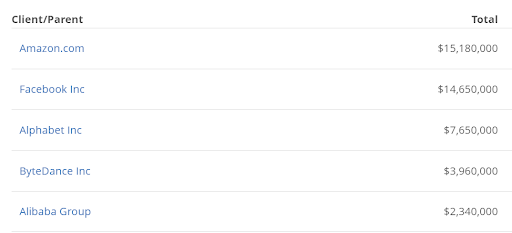
Notice some familiar names? It’s not surprising, but lobbying on behalf of tech giants post-2016 increased by tens of millions of dollars:
“In recent years, the tech industry giants have shelled out large amounts of money especially in response to criticism from lawmakers over privacy issues, antitrust concerns and more.” Krystal Hur, OpenSecret.org
Is it widely speculative to assume a bill might be shot down entirely because of a few lobbyists? Maybe. It’s about as wild as the fact that dozens of congress members become lobbyists. Or the fact that businesses spend more money lobbying Congress than taxpayers do to fund Congress. Or as wild as the fact that the love affair between lobbyists and Congress members isn’t always figurative.
The fact of the matter is, lobbying of Congress might convince enough members to represent the idea that the BSA Act should die in Congress; as most bills do. It’s important to keep that in mind no matter where the majority public opinion seems to be, or the opinion of many advertisers — money talks, after all.
Why Was the Bill Introduced? The US is Lagging Behind on Tech & Data PolicyThe Banning Surveillance Advertising Act may be a reaction to the rapidly changing trends of targeted advertising and increased user privacy prioritization that is already underway. To put it another way, consider the bill as potential government-backed enforcement of changes that have already started rather than an entirely new and/or sudden change. These are, after all, industry practices that have been under scrutiny and debate for years, rather than new or ground-breaking developments.
The GDPR and other European regulatory and legal bodies have been policing large advertising platforms and other tech firms in a very similar way. Aside from this, many big businesses have taken steps away from typical data gathering methods, such as Apple and the tracking opt-out included in the iOS14 update. Others like Google have already started phasing out third-party data and cookies on their own, albeit less swiftly.
The Cambridge Analytica Scandal Made Political Involvement InevitableTech companies enjoyed a long reign of self-regulation and little intervention from the government. Digital advertising methods were no exception, but that all changed after the Cambridge Analytica Scandal with Meta (formerly Facebook). As AdvertiseMint CEO Brian Meert notes, “No one really knew where the line was, but in 2016, everyone knew they crossed it.”
A vocal group of concerned citizens, including privacy-oriented companies like DuckDuckGo and Mozilla, had been raising alarm bells long before 2016. However, the scandal alerted everyone to the fact that this invasiveness concerned more than personal privacy – when in the wrong hands, it could influence democratic and political processes, and that self-governing policy clearly had not prevented this worst-case scenario.
Considering this, it was a matter of when not if the US government got involved, because Meta’s massive misstep in 2016 forced them to. Why it took them over five years to do so is anyone’s guess – hopefully, it was to become familiar enough with the digital world that they’re not so obviously out of touch this time around.
Common Viewpoints Surrounding The BSA of 2022For those in favor:It’s undeniable that some sort of legislation needs to be in place surrounding how data online is tracked and used by private companies. The fact that we made it this far without only makes sense when you watch just out-of-the-loop government officials are about the Internet, let alone decide on some sort of policy.
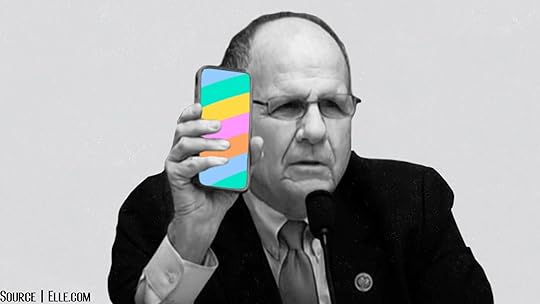
Either way, the bill is not too far away from similar regulations in place within European agencies. Entities like the GDPR aren’t perfect, but they’re also a step in the direction the majority of digitally native voters want privacy laws to go in.
This point gets skipped over a little too easily by marketers and other industry professionals when they discuss the impact of privacy laws. Too often, the discussion is framed as a potential detriment to a great method of reaching the right customers, as if customers aren’t aware of how much they benefit from targeted ads. This completely ignores the main point, that it’s the method in which targeted advertising is done that is the primary concern.
It also ignores the fact that most of those customers were never ok with that method in the first place. The reason this issue became such a big controversy wasn’t a sudden shift in public opinion; it was because few were aware to the extent their privacy was being invaded nor the implications this could have beyond selling products. By the time they found out, any hope of re-establishing that trust was long gone.
For those against:All of the above is a completely reasonable point of view, but that doesn’t make the Banning Surveillance Advertising Act of 2022 a reasonable solution. Regulation for data tracking and the use of data in advertising needs to at the least, draw a clear line for providers and advertisers to be aware of. As it stands, the bill is too broad to accomplish this.
Even if those specifications were to be made, it’s worth discussing whether those for the bill have a good perspective on who it is going after and hurting most. It’s easy to have no sympathy or concern for Meta, but the mood changes when you realize that it’s medical research, charities, and small local businesses that are impacted far more than any tech giant or corporation will be should the BSA pass as it stands.
Lastly, the public outrage and opinion don’t line up with the actions of most Internet users. The truth is, most of the very same people who voice concerns do not even bother to access the transparency tools they have access to, like public ad libraries, or Facebook’s complete account data logs and settings. Even fewer would be willing to pay for the platforms they’re seeking to limit.
It’s unreasonable to demand advertisers and platforms dismantle an entire economy like it’s a simple request. It’s even more unreasonable to simultaneously expect user benefits of the system you just abolished to remain.
The Most Common and Least-Discussed Bipartisan Opinion:The truth is, there is a consensus on the BSA across opinions and even party lines. It’s about the same as most bills, and it never gets discussed enough in the media. It sounds a bit like this, and speaks for itself:
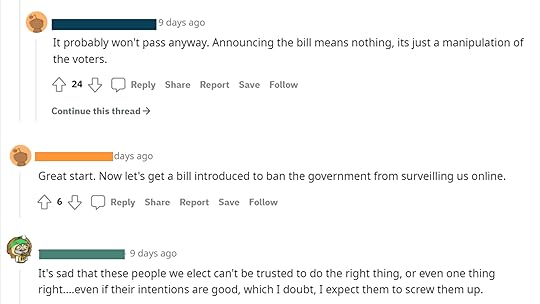
It’s generally agreed across major parties that there are some issues with the current state of privacy laws when it comes to advertising. While they each have slightly different stances on how they would like to address these problems, we can all agree on the fact that The Banning Surveillance Advertising Act of 2022 is far too early on in its journey through Congress to start drawing conclusions or discussing outcomes. It’s worth keeping an eye on because it does have implications for advertisers, advertising platforms, and users alike.
Realistically though, this is now a matter of US Congressional processes. That’s a polite way of saying the Act will either go nowhere slowly or will have amendments that change the discussion entirely if it does go anywhere.
January 20, 2022
Snap Advanced Conversions Looks Promising, But How Does It Work?


Snap’s Advanced Conversions is a data collection, analysis, and reporting process that provides quality advertising services and conversions reports while respecting user privacy and the increasing restrictions around data tracking. Its strategy and how it works make it especially promising compared to other solutions (or the lack thereof) currently offered up by platforms that previously relied on third-party data for advertising.
Advanced Conversions was officially launched in 2021, but its features and capabilities are being regularly developed and updated. Despite its infancy, it has already gained some controversy and is often labeled as Snap’s method of “bypassing” iOS data tracking opt-outs. The notion that Snap Advanced Conversions “skirts around” data opt-out and tracking rules is found throughout recent media, but it doesn’t paint a very accurate complete picture of this new feature and what it actually does.
For investors, advertisers and users alike, it’s important to get an idea of how Advanced Conversions works. This article is a good starting point if you are one of the above, and will cover:
A simple summary of what Snap Advanced Conversions isA straightforward explanation of how Advanced Conversions worksImportant upcoming developments and updates A deep dive into why these developments are important to keep an eye onHow Advanced Conversion Works, in Snap’s Own Words:Snap explains Advanced Conversions in three steps:
Obfuscating impression and conversion data so it can no longer be traced to an identifiable account or userCombining this data together and sorting them into groups that are useful for ad optimization and reporting using cohort analysisRepeat steps 1 and 2 on a daily basis. Reports are delayed by 36 hours to prevent real-time attacks and make the results even less traceable to any particular user or account.It sounds straightforward, but to make things more clear, let’s break those three steps down further in a more simple way.
How Snap Advanced Conversion Works, Complete Breakdown:The best way to understand how Advanced Conversion actually works is to compare it with traditional ad optimization and reporting to understand what it’s attempting to avoid and solve. The goal of every digital advertising platform is to provide businesses with ad placements that result in clicks, conversions, and sales. Data is key to doing this.
So now, the question for digital platforms like Snap is: How can we give results to businesses only data can bring, but without the invasion of privacy that ad optimization and reporting previously relied on upon?
Step 1: Make personally identifiable data from Snap and the advertiser unusableSnap Advanced Conversions solves this by taking the focus away from exact, user-identifiable data and focusing instead on the meat and potatoes of what advertisers were looking for in the first place: groups and patterns in data that are useful for insights so they’re not showing ads to random uninterested people, they know where their ads are going, and what gets clicks.
To do so, Advanced Conversions relies on two sets of data: Impressions data (first-party data from Snap) and Conversions data (first-party data from the advertiser). This data includes identifiable information by nature — most first-party data does. However, Snap obfuscates both of these datasets separately so that:
a) Impressions data does not give the advertiser any identifiable information of Snap users,
b) Conversions data does not give Snap any identifiable information of the advertiser’s conversions and customers, and
c) Identifiable information from both sets cannot be combined to use in ad optimization and reports, or be accessible to any outside companies.
The user data that makes you identifiable as a person or by your device are things like email addresses, phone numbers, and IDFAs (i.e. a tracking number for Apple iOS devices specifically for advertising). Obfuscating data means the process makes these pieces of information unintelligible and unusable so that they are not joined or used in any way in the next step.
It’s the data equivalent of black bars redacting sensitive details on a document before handing it over to someone else. This obfuscation prevents Snap from ever learning what its users are doing on other sites or apps, and the same for advertisers. Because the data sets are obfuscated before analysis is ever done, potential bad actors can’t simply “decode” this obfuscated data in analyses and reports either, as the information was never a part of the equation when making them and was not obfuscated as one unified dataset.
Step 2: Combine the remaining information to find useful patterns, groups, and traitsThe now-obfuscated datasets are now combined and organized into different groups with common characteristics. These common characteristics are extremely important and helpful in creating the same conversion reports that advertisers and businesses are familiar with, and can reliably give advertisers insight into how well their campaign performed.
It can’t and won’t, however, give them any insights at a user level. In other words, it’s all aggregate data that paints a good picture of the advertisers’ audience on Snapchat for important campaign metrics without ever handing out any names.
You can think of it as a buyer persona — it’s accurate, detailed, based on heaps of information about real people, and you can use it to get real results when trying to reach them. You can even compare it to the customers you know firsthand, but you can’t pick it apart to figure out the specific people behind all these informative insights.
Step 3: Continue this process every day, with reports delivered to the advertiser 36 hours after the fact.This delay is purely for the sake of privacy, making it harder to try and draw connections between real-time user activity and insights in conversions reports. The delay is also a security measure against any outside entities attempting to do the same thing if attacks were to occur.
Current Limitations of Snap Advanced ConversionsAdvanced Conversions was updated a few months after its 2021 launch to allow advertisers to see a small portion of real-time analysis, but it takes 36 hours to receive the entire report from the Advanced Conversions process. This 36-hour timeframe isn’t entirely accurate though, as Snap recommends waiting ~72 hours before drawing any conclusions.
This is the system’s biggest drawback for advertisers as of now — the delay is not only frustrating but also leads to confusion for those not used to it.
For example, the delay can cause CPX (any “cost per ___” metric) to initially look much higher than what the advertiser’s max bid was even after the full 36-hour delay. The real metrics become more accurate after a few days of daily analysis and full reports, but any advertiser that doesn’t read this note on Snap’s information on Advanced Conversions might reduce their max bid in reaction and hurt their own campaign in the process.
If the advertiser found any relief in the lowering CPX metrics a few days later, they might be a bit disappointed to see that their returns lowered with it as well — ROAS also suffer the same initial over-projection for the first few days and become more accurate in the same 72-hour timeframe.
This also makes any A/B testing difficult, at least if you’re trying to do so in a timely manner. You can’t rely on any estimates or modeling figures either; the system currently does not provide any.
All of the above is why Snap quickly decided to include a snippet of the real-time analysis for advertisers while they wait for full reports to kick in. Still, it’s hard to ask advertisers accustomed to real-time reports from third-party data to be patient, especially when platforms with tons of personal first-party data don’t have to ask them to.
Upcoming Updates and DevelopmentsSnap keeps their description of upcoming developments fairly vague: Advertisers should expect a “more holistic, real-time view” of results — but no word on exactly when other than early 2022, and they leave this note with “More information to come.”
What we do know is that they’re intending on addressing Advanced Conversions’ one major flaw of delays, and we know roughly how they plan on doing that: conversion modeling, to provide those estimates the process currently doesn’t have.
Though Advanced Conversions is a novel process of reporting that is far from perfect now, it has a good track record of delivering on promised launches and updates thus far. If we use that credibility to make any guesses of this near-future update, it’s safe to say that whatever month coming up the update is released for Advanced Conversions, it will be exactly what is promised; the solution to the system’s few growing pains, and perhaps Snap’s next big win.
Why You Should Keep An Eye on Snap’s DevelopmentsTraditional advertising on most digital platforms relies heavily on third-party data in order to find the most suitable audiences and track important aspects of campaign performance like impressions, conversions, and click-through rate (CTR). This caused issues for many major platforms as the usage of cookies and other data tracking methods began to decline. It’s such a pillar of discussion in the digital economy, you’d have a hard time not reading about it in business media.
The lack of sufficient data for advertising due to opt-out policies like the iOS14 update resulted in losses in ad revenue, plummeting share values, and general frustration from the businesses relying on these platforms for their ad campaigns.
The consensus is to abandon its usage completely in favor of first-party data, but this is yet another problem: It’s nowhere near as widely available.
Some platforms automatically have plenty, like Amazon or TikTok, due to how the platforms work and the permissions given by users in order to access them. However, a typical social media platform does not. In other words, there is no way for companies like Meta or Snap to provide the same quality of advertising by simply swapping third-party data out with first-party data in their traditional reporting and optimization systems.
They can’t rely on the third-party data they already have either. Personal preferences, interests, and even basic information like emails are subject to change, which makes most third-party data unreliable unless it’s fresh and regularly updated.
For companies in this predicament, there is no standard alternative solution in place to save their advertising, a.k.a their main source of revenue and what makes the platforms free to use. As a result, most are opting (read: scrambling) to internally develop their own solutions according to their resources and requirements.
Due to the nature of first-party data and the changing social media landscape, it’s unlikely that there will be one widely accepted method for ad optimization and reporting for quite some time, if ever. But whichever company manages to figure out the best way to provide the reliable advertising that businesses grew accustomed to will win big as we approach the inevitable death of third-party data advertising — so long as advertisers and investors aren’t waiting for too long, that is.
According to Snap, they won’t have to; unless they insist on waiting for the metaverse.
January 13, 2022
14 Hidden Benefits of Social Media Marketing for Business


Social media marketing is a must for most successful businesses seeking new customers and a wider audience (and a must if you want to do viral marketing, too). However, it’s not just about having a Facebook advertising campaign and tweeting out your products every once in a while – with the right strategy, there are benefits to social media besides more traffic and more sales.
In this article, we’ll discuss 14 lesser-known benefits of social media marketing for business owners. We’ll also cover 4 potential drawbacks so you can enter the world of social media for business with confidence and determine if now is the right time for your brand to start its own social media strategy.
Immediate Benefits of Social Media Platforms for Business1) Easily Generate Customer Created Content
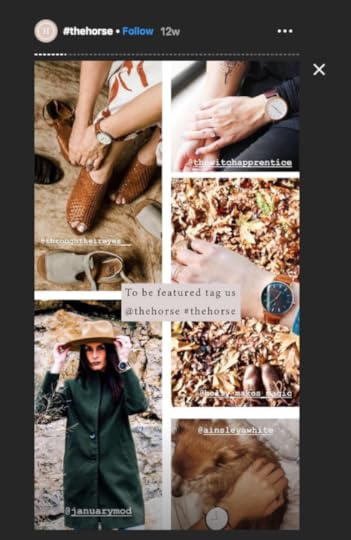
Social media channels make it easy for customers to spread the word about your business and generate tons of free marketing material. For example, the popular cleaning brand “The Pink Stuff” became a sensation on TikTok and even landed themselves a spot on Amazon’s Internet Famous page as users submitted videos of them using the pink products for a variety of household cleaning chores.
The unique look and multipurpose usage of The Pink Stuff allowed social media to serve as free advertising, but any brand can use social media platforms like Instagram, TikTok, Snapchat, and Facebook to encourage, engage with, and share user-generated content from happy customers while saving on marketing costs at the same time.
2) Find & Nurture More Top-Funnel LeadsGenerating leads is one of the main goals for any B2B marketer, and social media can help businesses efficiently find and nurture more top-funnel leads. Platforms like LinkedIn provide an incredible opportunity to connect with potential customers in a professional setting, and Twitter’s lead generation cards make it easy for interested individuals to fill out forms with just one click.
Lead generation via social media marketing isn’t exclusively beneficial for B2B marketers either: Social media platforms can be used to encourage people to sign up for loyalty programs, newsletters, or special events. In the era of first-party data, these audience lists are extremely valuable for any successful marketing strategy and can help you target future campaigns more accurately.
3) Observe & Analyze Your Competitors Photo by Carlos Esteves on Unsplash
Photo by Carlos Esteves on UnsplashSocial media is a great tool for observing and analyzing your competitors. For example, by searching “Whole Foods” on Twitter, you can see how many people are talking about the brand today or what articles they’re sharing with their audience members. You can also view Facebook pages of other large brands to determine which social media marketing strategies are working best for them and which ones you should avoid.
Competitor analysis can help your business in a few ways: You might find that one of your competitors is using a social media marketing strategy that you hadn’t thought of, decide to focus on a different demographic than what another company is targeting, or even borrow an idea or two for future content promotion or organic posts.
Long-Term Benefits of Having a Social Media Strategy Photo by Kaleidico on Unsplash4) It Gives Your Brand a Bigger & Better Personality
Photo by Kaleidico on Unsplash4) It Gives Your Brand a Bigger & Better PersonalitySocial media marketing allows brands to show off their personalities and connect with customers on a more personal level. Companies can build trust and customer loyalty by communicating directly with people through social media feeds that have been designed specifically for each platform.
The personality factor of social media platforms for businesses is true for large companies and even individual professionals. For example, both RyanAir and Lawyer Mike Mandrell have found dedicated followings on TikTok. RyanAir shows off its brand’s casual character in its content ideas by hopping onto trends and showcasing employees having fun with it, while Mandrell, better known as “Law By Mike” has gathered a dedicated community throughout social media by offering legal advice and opinion on trending topics and updates on big ongoing lawsuits.
5) You Can Practice Social Listening for Better Marketing & ContentSocial listening is the process of monitoring online conversations to see what people are saying about your brand, products, or industry. This information can be used to improve marketing strategies and content, including blog content or copy on your website.
The best way to practice social listening is by setting up alerts for specific keywords and phrases related to your brand on Twitter, LinkedIn, Facebook, and others. You can also take advantage of social media monitoring tools to monitor your brand’s mentions across the web.
Social listening has a few uses directly related to your business, too: You can get direct feedback from ideal customers about how they feel about certain products or services, identify potential influencers that might be interested in working with you on future campaigns and find people who may have had a negative experience with a competitor in the past.
6) You’ll Refine Your Target Audience (or Find New Ones)

Now that third-party data and cookies are on the way out, getting your hands on quality data for audience targeting is more important than ever. Through careful analysis of data from your social media presence, you can determine who your current and potential customers are, what they’re interested in, and where they hang out online to get more engagement and drive traffic to your site or store.
This information can be used to improve ad targeting on social media platforms and throughout your business. For example, you might find that certain keywords and phrases attract a very specific demographic on Facebook while others will only appeal to users who are interested in your industry or geographic location.
Refining your target audiences through social media marketing can help improve conversion rates by sending the right message to the most receptive people possible. It’s especially useful for creating audience lookalikes or remarketing campaigns. More often than not, your social media marketing campaign can help find entirely new audiences you never considered marketing to.
7) Use Social Media Channels to Enhance Your Customer Journey
The customer journey is the process that customers go through when interacting with your brand, from becoming aware of you and your products to making a purchase and becoming a loyal customer. A well-designed social media strategy can help improve all stages of the customer journey and target users to boost website traffic and sales.
For example, you can use social media to create awareness for your brand by sharing valuable content and updates, engaging with customers who are interested in your products or services, and hosting giveaways to attract new followers.
You can also use social media to improve engagement with customers at all stages of the customer journey by hosting events like live Q&A sessions, running contests for your followers, or conducting polls that give valuable feedback on new products and services, which you can turn into actionable goals for your business.
Social Media Benefits for Small & Local Businesses Photo by Tim Mossholder on Unsplash8) Improve and Personalize Your Customer Service
Photo by Tim Mossholder on Unsplash8) Improve and Personalize Your Customer ServiceSocial media is a godsend for small and local businesses hoping to quickly and affordably provide customer service. By monitoring social media platforms for negative feedback and complaints, you can address issues before they become bigger problems.
You can also use social media messenger apps to allow customers to schedule appointments and reservations or ask questions directly through the platform. The convenience and ease of use for the user are key aspects of social channels for business that drives more leads and sales. If there are more customers than one employee can handle, automated chatbot subscriptions can automatically answer and categorize leads from messenger apps in the thousands, with providers like ManyChat offering affordable rates for small and local businesses using Instagram and other popular channels.
You can also use social media to personally address customer feedback and questions that would be difficult or time-consuming for your support team to handle via email, phone call, chat, etc. Knowing what your customers want and expect from you on every platform allows you to provide truly personalized service in an otherwise impersonal world.
9) Become a Part of More Genuine Community EngagementLocal businesses have a lot to gain from becoming a part of community groups and conversations on social media. It’s common on platforms like Facebook for people to set up private groups for locals only or based on interests. Quora and Reddit also provide plenty of opportunities for engagement within organized groups and interests, including locations. Participating can do wonders for your brand reputation as people see you and your team involved in community matters. These groups may not find your website via search engines, so having a social media presence within them can really boost awareness for your business.
Just be sure to keep your engagement in these groups genuine and avoid social media advertising – the goal for this kind of engagement is brand awareness and reputation, so you won’t want to use these spaces for blatant promotional posts and social ads unless given specific permissions to do so. However, they can be great for general discussion, answering questions, or promoting a blog post or two.
10) Be Seen as a Pillar Figure in Key Communities & Groups (Online and Offline) Photo by Hannah Busing on Unsplash
Photo by Hannah Busing on UnsplashThere’s no better form of advertisement than a great reputation, especially for small businesses. Once you’ve involved your brand or business in specific social media groups or communities and established yourself as a contributing figure, consider using this to bolster your brand authority further by participating in local events, charities, and supporting other businesses or individuals beyond social media engagement.
The more involved and well-respected your brand becomes in the communities it participates in, the easier it will be to convert leads into customers. Though most of this engagement is offline activity, it provides plenty of discussion and content for wholesome social media posts. And that’s a benefit we can all get behind!
11) Get Access to Affordable (Or Even Free!) AdvertisingThanks to targeted ads and boosted posts, businesses can reach their target demographics for pennies on the dollar when compared to traditional advertising methods. You can make and track your social media advertising and organic content yourself through Ads Manager and other social media advertising tools, though it may take some time to get used to all of the complex settings and setup options. If you’re running several campaigns at once or large-budget campaigns, hiring an expert digital advertising agency can ensure you reap the benefits of social media ads without any headache.
With a brilliant social media strategy, it’s also common for businesses to enjoy free promotion by word-of-mouth as users create and share content related to certain brands and products. Some small businesses don’t need to spend a dime on marketing once they’ve nailed social media marketing.
Benefits of Social Media Platforms for Growing Companies Photo by Austin Distel on Unsplash12) Preserve Your Brand’s Personal Touch
Photo by Austin Distel on Unsplash12) Preserve Your Brand’s Personal TouchGrowing from a shop or website to a full-fledged business enterprise is quite the process, and maintaining brand integrity is vital to a successful transition. Social media is an easy way for businesses to maintain a personal touch to their brand identity and maintain genuine engagement with their audiences even at scale.
Even large corporations like Wendy’s frequently use platforms like Twitter to respond individually to users – usually jokingly – which has really defined the company’s character over the past decade or so. All it takes is a dedicated social media manager to preserve your brand’s personalized tone and communication even as your audience grows from the thousands to millions.
13) Stay Relevant in Your Industry Photo by Timothy Hales Bennett on Unsplash
Photo by Timothy Hales Bennett on UnsplashA smart and established social media presence can be the difference between staying relevant as a company and being out of the loop on trends, topics, and public opinion. Regular posting and engagement with users on different social media platforms allow you to keep your brand on people’s minds and they serve as a free information hub on communities, competitors, and your industry to be sure you’re always keeping up with the times.
Information and trends gathered from social media can help keep your website content, social media posts, and messaging as fresh and relevant as possible. They can help inspire new topics to cover, keywords or hashtags to use, or even new product lines if your brand deals with seasonal or fashion items. Making social media marketing a key part of your strategy ensures that no matter how quickly your market and industry evolve, you’re always one step ahead of the curve.
14) Safely (and Cheaply) Experiment with New Marketing Strategies and Social Media CampaignsA business should never stop experimenting with new marketing strategies, but some of them can be very costly and may not always pan out. Growing businesses in particular require a lot of testing and experimentation with their campaigns as they continue to evolve and scale their brand identity and messaging and make the switch from DIY to professional, large-scale advertising campaigns.
Social media provides a much safer and cheaper space to experiment with new ideas before rolling them out on other marketing channels. Helpful analytics features keep track of different metrics for your team to successfully implement A/B testing, and experimental campaigns can be easily altered and scaled depending on their success rates. The ability to “dip your toes in the water” so to speak with different formats, objectives, copy, and creatives ensures that your marketing strategy improves as your company grows.
Potential Disadvantages & Key Considerations Photo by Jason Dent on Unsplash1) Getting the Most Out of Social Media Requires Investment
Photo by Jason Dent on Unsplash1) Getting the Most Out of Social Media Requires InvestmentIf you noticed that a lot of these points included words like “smart” or “dedicated” before “strategy,” it’s because the benefits of social media marketing can’t be achieved with a half-hearted attempt. Each platform differs by demographics, interests, sense of humor, and more, and communities within different social media channels also have their own hashtags, trends, and topics.
This means a considerable amount of time is required to ensure your brand is entering social media spaces the right way, especially if you or your team members aren’t actively participating in these spaces and aren’t aware of their digital culture. It’s always recommended you spend some time lurking around different platforms and communities you’re seeking to have a presence in before making any posts or hiring a social media expert who keeps themselves and your brand in the know at a professional level.
2) Audiences on Social Media Are Savvy and Sensitive to Messaging Missteps
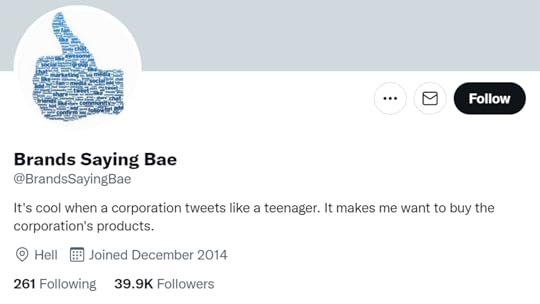
To emphasize the importance of time investment and research, it’s important to know that social media audiences react strongly and poorly to brands that enter their spaces the wrong way – even if their only crime was being a bit behind on trends. Corporate marketing in the digital world has left many users and communities ad-averse and wary of businesses on social media; this means that as a business you need to take the necessary steps to ensure what you’re posting and how you’re reaching out to your audiences is suitable for your platform, communities, and brand.
Additionally, not all trends on social media are a good fit for every brand. Some aspects of social media culture, trends or slang might reflect poorly on your brand even if you use them properly in your posts or campaigns. The damage this can do to your reputation may not be worth the temporary attention of a trending post, and that attention might not be from your target audience, to begin with — something that plenty of brands attempting Twitter advertising have clearly not learned.
3) Good Social Media Strategies Win Big…But a Bad One Can BackfireOur in-depth look at viral marketing strategies goes into these topics in more detail, but social media campaigns run the risk of backfiring just as much as they do succeeding. Sometimes, it can just be a “cringe” post in poor taste that is quickly buried. However, plenty of brands go viral for all the wrong reasons as millions of users point and laugh at their failed attempt at entering social media spaces.
Which one do you think the average social media user is more likely to remember: the 2018 U.S. midterm election candidates or Wendy’s awful 2018 “Like a Boss” commercial? These social media blunders stick out in people’s minds, but it’s not for no reason – out of touch or slightly “off” marketing on social media is akin to a business posting that they don’t understand their customers where everyone can see. People will be sure to spread the word to communally shame a brand that messes up in this way.
Smaller businesses have a bit more room for forgiveness and therefore more wiggle room to make some mistakes on social media because they have a more personal feel and touch to them. The larger your brand is, however, the bigger a bad post or campaign can backfire completely, and the less forgiveness you’ll receive from the Internet if it does.
4) Social Media Marketing Is a Long-Term Strategy Photo by Alexandar Todov on Unsplash
Photo by Alexandar Todov on UnsplashThere are some social media masters out there that can establish a brand’s presence on a platform and get the ball rolling impressively fast. Generally speaking though, these social media marketing benefits mentioned shouldn’t be expected quickly. Achieving all these benefits requires a long-term strategy that needs ample time and investment to pay off. You can’t just send one tweet or create an Instagram post and expect your business to flourish overnight – it takes months, tons of research, and constant engagement with various communities on social media for you to be able to reap the full benefits of every platform.
Additionally, social media marketing success is very hard to measure. It falls into the same category as content marketing, where the best ways to measure success aren’t always precise numbers, and sticking to hard numbers only to measure success (e.g. number of likes and shares) can easily lead you to the wrong conclusions. If you’re considering entering social media as a business for the first time this year or are shifting your marketing focus primarily to social media, keep in mind that it’s more of an investment of time than anything else.
ConclusionSocial channels bring in plenty of benefits for businesses looking to expand their brand awareness, build relationships with current customers or prospects, provide customer service, promote products and services organically, and much more. These 14 benefits outline the tip of the iceberg regarding the payoff social media can offer businesses, but it’s important to keep in mind the 4 key drawbacks of social media we covered before entering a new space as a brand as well. With the right balance of effort, awareness, and authenticity, any brand large or small around the world can experience how social media marketing benefits businesses for themselves.
Is your business large enough to require the help of an expert digital advertising agency for your social media marketing campaigns? Consider your budget and goals to determine whether digital experts are your best bet for achieving maximum ROI and experiencing the benefits of social media for businesses.



